

Designation:AF-1 Vulture (-1A, -1B, -1D) |
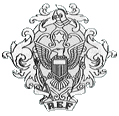
|
||||
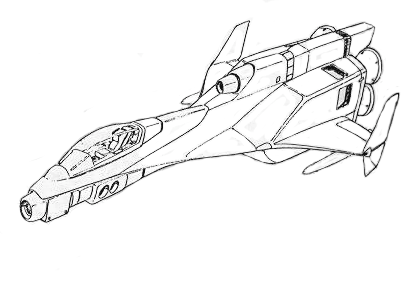
|
|||||
| Total Length: | 14.1 m |
| Total Height: | 4.2 m |
| Total Wingspan: | 10.2 m |
| Total Dry Weight: | 16.2 metric tons |
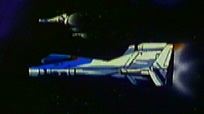
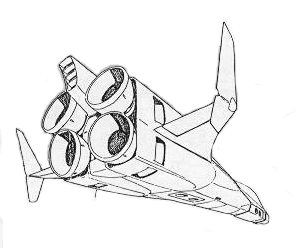
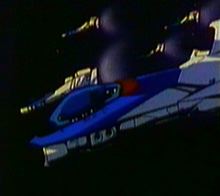
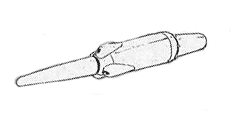
The skin of the Vulture is composed of an advanced titanium-steel alloy. The armored skin stops all small arms fire, provides good protection against heavier infantry weapons, such as a 12.7mm machinegun round, and fair resistance to light mecha-mounted weaponry, such as the Zentraedi 22.3mm HE autocannon round. The total protection is marginally better than that on the Valkyrie. The Vulture provides full protection from nuclear, biological, and chemical hazards, using an overpressure cockpit environment activated by radiation and hazardous chemical sensors, or manually when biological warfare conditions are anticipated. The internal consumables supplies can provide atmosphere for one day maximum.
The AF-1 Vulture was a non-transformable Fighter designed primarily for use in space, specifically for fleet defense roles. In 2013, the first Lightnings and Alphas were being built, but like the Valkyrie, these Veritechs were three or more times as costly as a standard non-transformable fighter, in money as well as in manufacturing time. Thus, after some parliamentary pressure, study groups were begun to examine the feasibility of a non-transformable plane, continuing the lineage of Hunter and Lancer space fighters.
Later that year these groups reported that, at least in space, the Zentraedi Fighter Pod, a non-transformable design, was nearly as potent as the VF-1 and VF-4. While in near-ground battles the added versatility of the Veritechs would have some added value, in space at least their anti-starship tasks could be done more cheaply by a non-transformable fighter, which could also be built faster and in greater numbers.
In early 2014, during the first production runs of the Lightning, the craft that would become the Vulture was designed. As the main purpose of this mecha would be space defense, and because the craft need not carry the extra equipment required of a transforming mecha, the designers found sufficient room and weight to make a truly impressive aircraft. Most notably, the Vulture was literally built around one of the largest single guns ever mounted on an aircraft, the EP-100. This gave the AF-1 Vulture a very heavy forward punch. No missiles were to be mounted internally, but the three hardpoints could mount four nuclear anti-starship missiles, or up to 36 anti-mecha missiles. Typically, however, the Vulture carried a jammer/sensor pod on the upper hull hardpoint, and missiles on the others. The Vulture did have wings, and the two lower engines were full fusion turbines complete with air inlets and all. However, as the mecha was intended primarily for space duties, the two upper engines were converted to a dedicated internal reaction mass mode, forcing them to a plasma-shock expansion engine profile in an atmosphere. Furthermore, as the plane was optimized for space, the small wings and boxy fuselage made the mecha less maneuverable in an atmosphere, while the extensive reaction mass tankage that gave the Vulture an extended range in space limited its abilities as an atmospheric fighter even more 'down below'. Hence, though the mecha could develop great bursts of speed in an atmosphere, it was never utilized there in combat situations.
Design, testing and production all took place ahead of schedule, with the initial service entry in 2016. In 2019 there were over two thousand Vultures operational with the Tokugawa-class carriers and the other RDF Spacy forces. During the early 2020's, however, four of the five battlecarriers were converted to landing ships, reducing their complement of Vultures to about a hundred each. Though many were reassigned to the Hannibal (whose complement swelled by two hundred planes), 800 Vultures were placed in reserve storage at the Tranquility Sea storage and repair depots, the rest being divided among the SDF-3 and the REF's Tristar-class light cruisers. Those that remained in service with the REF Navy saw a major upgrade to the avionics and control systems, and were renamed the AF-1B. In November 2029, the Hannibal returned to Earth and was destroyed in an abortive attack on the fleet of the Robotech Masters. Most of her air group went down with her, and in one stroke, the number of operational Vultures was cut by almost two-thirds. After 2033, the Vultures that remained were slowly phased out of service in favor of the Beta Fighter and in 2043 only 100 reserve mecha remained in Planetary Guard squadrons on Tirol.
Return to REF Aircraft Index.
Return to UNDF Aircraft Index.
Go to Robotech Reference Guide Home Page.
Robotech (R) is the property of Harmony Gold. This document is in no way intended to infringe upon their rights.
Content by Pieter Thomassen and Peter Walker